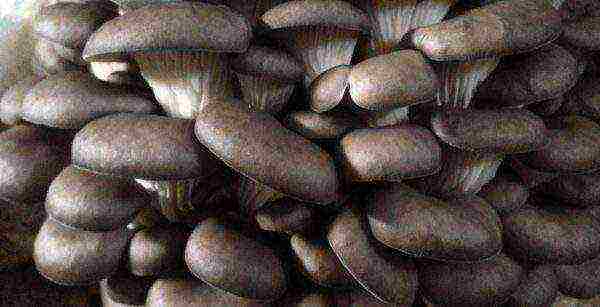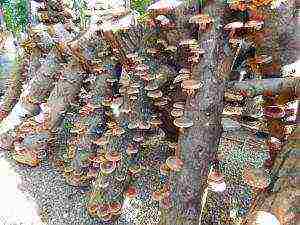Content
- 1 Different ways of growing
- 2 Basement preparation
- 3 Substrate procurement and processing
- 4 Basics of cultivation technology
- 5 Incubation and cultivation
- 6 Harvesting
- 7 How to choose a place to grow
- 8 Basis for growing oyster mushrooms
- 9 Mycelium selection
- 10 Purchasing quality mycelium
- 11 The main stages of breeding oyster mushrooms
- 12 Oyster mushroom diseases and pests. How to prevent and control
Growing mushrooms at home allows you to harvest all year round. This allows us to consider it as an additional source of income. From this article you will learn how to grow oyster mushrooms in a basement.
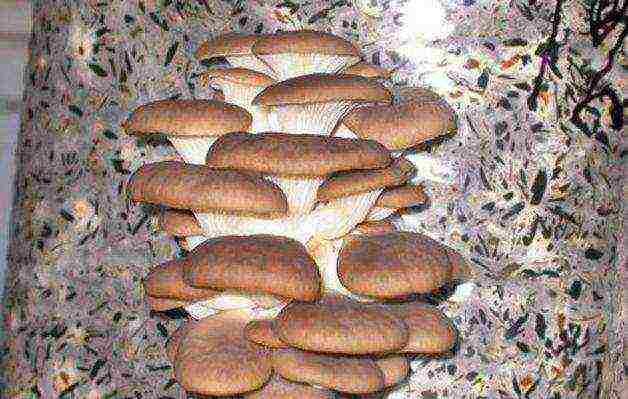
Different ways of growing
Oyster mushrooms can be grown in two ways: extensive and intensive. Extensive assumes the use of natural conditions and is considered more profitable in terms of investments. The intensive uses an artificially created environment.
Both methods have disadvantages. The disadvantages of growing in a natural environment include the ability to harvest only once a year and complete dependence on external conditions. The second method requires a fairly large investment and has many organizational nuances.
For those who want to grow mushrooms in the basement, both methods are suitable. It all depends on the equipment available and personal preference. In fact, the replanting technology is common, only the volume of the crop changes. This article will describe an intensive method using a special substrate.
Basement preparation
Before you start growing mushrooms, make sure that the conditions in your basement meet all the requirements. If at least one of them is not observed, you will not be able to maintain the required microclimate and your entire crop will die.
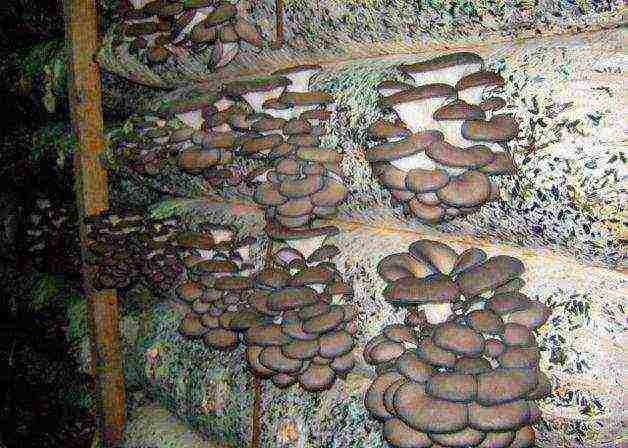
Oyster mushroom is successfully grown in basements.
So, what should be in the basement where oyster mushrooms are grown?
- Stable temperature from 10 to 20 ° C.
- Air humidity from 85 to 90%.
- Sophisticated ventilation system.
- Free from mold and pests.
- Purity.
If you look at the list and find any problems, be sure to fix them. It is recommended to start preparation with cleaning. It will help you find sources of problems and free up space for shelving and equipment.
To achieve the required temperature, you need to make the room airtight and think over the heating system. Usually, to warm up the basement, you need to insulate the floor and walls. After that, one heater will be enough for you, which must be turned on once a day.
Air humidity is not only related to temperature, but also directly depends on the dryness of the basement. If it is periodically heated by groundwater, it will be difficult to regulate humidity. After solving all the problems with tightness, air humidification will be carried out during irrigation.
Mold in a vegetable basement can be a major obstacle to a rich harvest. Fight it by warming up the room, regularly cleaning and covering the walls with special antifungal paint.
At the slightest suspicion of pests, call professionals or carry out pest control yourself. It is most convenient to use a smoke bomb and industrial insecticides. Remember that after processing, at least 1 week must pass before laying the blocks with the substrate.
The final step in preparing the basement is thorough cleaning and disinfection. It is carried out using a 1% chlorine solution or bleach. Please note that in addition to the basement, you will need a separate warmer room for the incubation of oyster mushrooms.
Substrate procurement and processing
First, you need to buy mycelium and the substrate on which the oyster mushrooms will grow.Suitable substrates are dried stems, hay, buckwheat and seed husks, and hardwood shavings. The main requirement for the substrate is the complete absence of mold and rot.
Collecting the substrate yourself is a difficult task. All beginners are advised to purchase ready-made material, packaged in dense plastic bags. When buying, pay attention to its composition. It is important that it is suitable for growing oyster mushrooms.
Substrate processing can be carried out in the following ways:
- hydrothermia (use of hot water);
- pasteurization (blowing steam over a humidified substrate);
- xerothermia (blowing steam over dry material).
The purpose of such processing is to make the substrate looser, to fill it with oxygen and other useful substances. The root system of fungi will develop in a comfortable and fungus-free environment. This will speed up your oyster mushroom growth and allow you to harvest several large crops per year.
To prevent mold growth, dry the substrate thoroughly after rinsing. To do this, leave it to dry in a warm place for 2 days. During this time, all excess fluid will drain.
After that, the available raw materials are crushed and mixed. This will help the substrate to retain water better. The resulting material is completely ready for planting oyster mushrooms.

Oyster mushroom grain mycelium.
If you decide to purchase the vegetative body of the fungus, that is, the so-called "mycelium", carefully approach the choice of the supplier. To get started, buy a small trial batch. Be sure to check the information on the supplier's certificate and on the labels. The most important points for you are germination rate, resistance to disease and fungus, variety and shelf life.
Mycelium should be free of ammonia odor, black or gray spots (this may indicate incipient mold). It should have an orange or yellow tint.
It is very important to know if all storage conditions have been met. Oyster mushroom mycelium should be stored at + 3-4 ° C in a basement or refrigerator. Transport temperature should not exceed 20 ° C. Subject to these conditions, its shelf life is 6-9 months, depending on the variety.
After you purchase the mycelium in bags, leave it at room temperature for 1 day. Then fold them apart from each other so that they can freely access the air. Keep in mind that the shelf life at home is significantly reduced, so you should start planting as soon as possible.
Before laying, carefully chop the mycelium without opening the bag. After that, briefly transfer the bags to the room with the substrate, that is, to the basement. This is necessary so that the temperature evens out, and the mycelium does not die from shock.
The opening of the bag with mycelium should be done exclusively in a clean room. Use gloves and disinfect the table with an alcohol solution. It is worth noting that the cultivation of oyster mushrooms and the planting of mycelium should be carried out in different places in order to avoid infection of the mycelium. If you don't have a separate room, use a divider to create a small space in your basement.
Basics of cultivation technology
The whole technology of growing oyster mushrooms can be roughly divided into 4 stages. The first involves processing the substrate. Methods for processing it are given in the previous part of the article. At home, the easiest way to prepare it for use is with hot water. Add water so that it completely covers the substrate and boil for 1.5 hours.
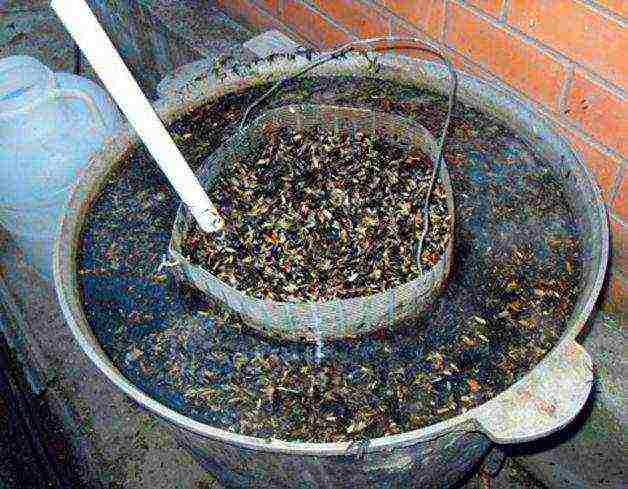
Pre-boiling the substrate.
Many people prefer to boil the substrate directly in plastic bags. In this case, you need to make several holes in them so that the water can circulate calmly. After draining the water, it is advisable to place the substrate under a press and leave for a day to remove all excess liquid.
Laying of oyster mushroom mycelium should be carried out only in sanitary conditions.Disinfect the basement first, treat the bags with alcohol and put on gloves. If there is ventilation in the room, it must be temporarily blocked to prevent the spread of fungus. Also wash the work surface with disinfectant and water.
Pour the mycelium and substrate on the table, mix them, taking into account that the total mass of the substrate should account for 3% of the mycelium of domestic producers and 1.5-2% of the mycelium of foreign manufacturers.
Put the resulting mixture in special bags of 10-15 kg and tamp it tightly. If you are trying to grow oyster mushrooms in your basement for the first time, use 5 kg bags. The smaller the volume, the easier it is to regulate the temperature inside the block.
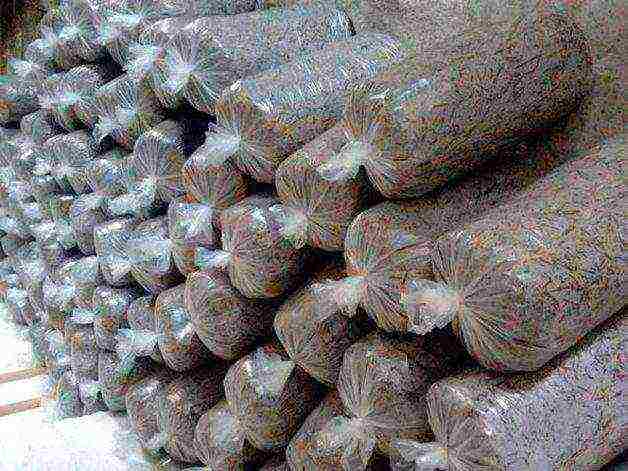
Mushroom substrate bags.
When you have filled all the mix available, flatten the bags slightly on one side and perforate on the other. The cuts are made with a sharpened and clean knife at an angle of 45 °. The length of each cut should be 50 mm.
The packed bags are transferred to the incubation room, where the average temperature is + 25 ° C. They are placed on racks so that the perforated sides have free access to air. In addition, there should be free space between the bags. It must be at least 5 cm. It is forbidden to put them on top of each other. Now the third stage begins - incubation.
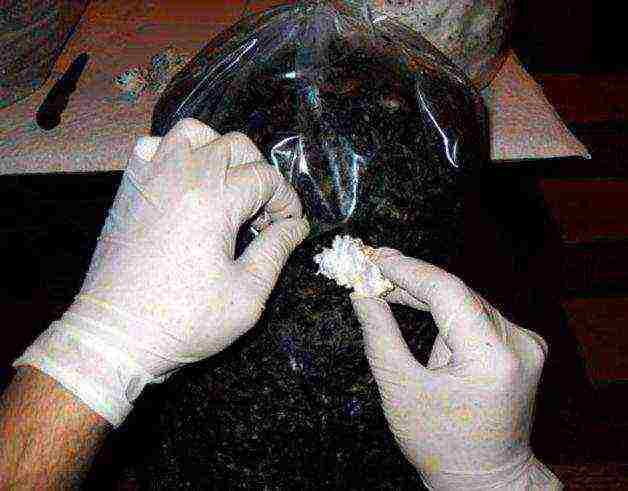
Laying the mycelium into the substrate.
Incubation and cultivation
The temperature at the incubation site should be constant and not fluctuate more than 1-2 ° C. If the temperature rises above 30 ° C, the mycelium will experience heat shock and future fungi may die. Even small changes in temperature reduce the likelihood of germination.
During incubation, the room must not be ventilated. The emitted carbon dioxide creates suitable conditions and slightly increases the humidity. To prevent mold and disease, clean daily with chlorine-based cleaning products.
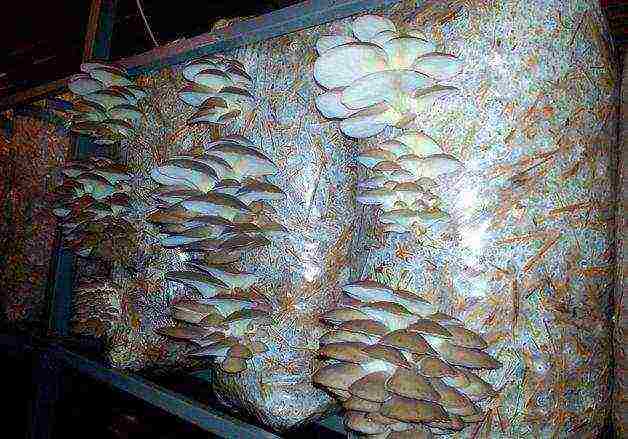
The emergence of fruiting bodies of mushrooms.
Typically, incubation takes 18-25 days. After that, the oyster mushrooms are ready for the last stage - cultivation. The bags should be carefully transported and laid out in the basement. They are installed vertically at a short distance from each other.
Further successful cultivation depends on the conditions that you create in the basement. Humidity should be between 85% and 95%. To grow mushrooms with a light cap, a temperature of 10 ° C is required, and at higher temperatures (up to 20 ° C), the cap will turn out to be dark. However, these differences do not affect the taste in any way.
The light intensity should be 5 watts per square meter. Mushrooms are watered 1-2 times a day with warm water using sprinklers.
Since mushrooms produce a lot of spores during cultivation, it is best to keep them away from living quarters. High concentrations of spores in the air can cause allergies.
Harvesting
The first mushrooms should be expected in 1.5 months. After removing them, you can wait for a re-harvest in 2-3 weeks. In order for the crop to appear quickly, you need to completely cut off the legs and sort out the substrate. If a block has become moldy, it must be removed from the basement immediately and used as fertilizer. If you do everything right, oyster mushrooms will bear fruit within six months.

Oyster mushrooms can be harvested several times throughout the year.
With the right approach, growing oyster mushrooms in the basement can be considered an additional source of income. The main disadvantage of this way of earning is the need for capital investment. But the numerous pluses clearly outweigh this minus. You will be able to grow a rich harvest that will not depend on the season, and will quickly return all your costs
Many people find it difficult to grow mushrooms in the basement.Perhaps not all mushrooms are suitable for reproduction in an artificial environment, but growing oyster mushrooms in the basement does not require special financial costs and efforts to maintain, while ensuring stable harvests of mushrooms at home. Sometimes this hobby turns into a profitable business very successfully.
Oyster mushrooms are not demanding on temperature and humidity, setting the average temperature from 9 to 30 degrees Celsius and humidity 80-85%, you can get a bountiful harvest. The high yields of oyster mushrooms are confirmed by the collection of three kg of mushrooms from one block; up to 500 such blocks are installed per 100 square meters.
Among other things, caring for the mycelium is not difficult.
Preparing the basement for growing mushrooms
For breeding oyster mushrooms in cellars, any underground premises with an optimally arranged microclimate are suitable. You do not need to build a greenhouse, but before growing oyster mushrooms, you need to ensure the cellar temperature is no more than 25 degrees Celsius.
The following conditions must be met in the basement:
- the temperature is set from 15 ° C to 20 ° C;
- humidity from 80% to 95%;
- good ventilation and adequate lighting.
It is necessary to maintain a balance of temperature and humidity, because even small fluctuations in the scale of degrees are immediately reflected in the humidity of the room. At 20 degrees of heat, the humidity is 90%, with a decrease of 1 degree, the humidity rises to 100%, and when heated to 21 degrees, the humidity is reduced to 82%.
In the basement, you should take care of hydro and thermal insulation. There is no need to re-equip the basement room, it is enough to use covering materials. Experts recommend covering the floor with straw, or covering it with a thin layer of sand or soil.
The main thing is not to forget to change the damp material in time.
Mycelium and oyster mushrooms require low carbon dioxide levels at the breeding site. To ensure their correct growth, it is worth considering installing centrifugal fans.
The oyster mushroom plantation does not require natural light or windows. You can use fluorescent light sources (called fluorescent lights). Conventional lamps, especially those of higher power, are not allowed to be used, since they can overheat the mushroom beds.
When choosing a material in which mushrooms will grow, one must take into account the strength and durability of their use, as well as resistance to moisture. Wooden and metal elements quickly fail, becoming covered with rot or corrosion, fungus and mold. For the installation of shelves, it is worth choosing plastic and concrete.
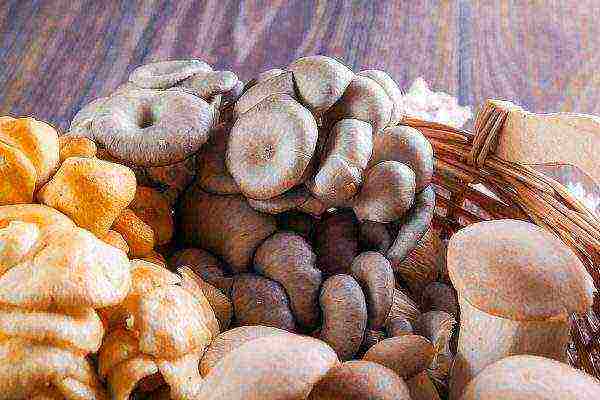
Oyster mushroom growing technologies
You can use one or several basements for mushroom plantations at home. It all depends on the technology used.
If, after the introduction of spores into the nutrient medium (inoculation), the blocks with mushrooms stand in the same room until fruiting, the development of the mycelium (mycelium) and harvesting take place in one place. This technology is called single-zone.
In the case when spore germination is done in one compartment, and fruiting is carried away to the second, a multi-zone method is used.
With single-zone technology, the basement area is saved, but there is a problem with maintaining the temperature, humidity and degree of illumination changed after germination. With a multi-zone design, it is necessary to equip several basements with constant conditions.
So, one basement room will become the germination zone, and the second - the fruiting zone. For the development of the mycelium, a temperature is needed higher than for fruiting. With the growth of the oyster mushroom mycelium, a noticeable amount of heat is released. If you arrange the mushroom plantations correctly, then you can significantly save on heating the basement.
Preparing boxes for oyster mushrooms
Planting of mycelium, as a rule, is carried out either in construction bags made of polyethylene, or in artificial stumps, which are placed on shelves. To prepare such stumps, you need parts of logs of any deciduous trees, 1.5 m in size and up to 15 cm in diameter.
Before sowing the mycelium, a cut is made in each stump to a depth of 5 cm. Between such cuts there should be at least 30 cm. The shelf is made of a metal profile, corners or wooden beams.
This four-story structure consists of racks and shelves on which stumps are laid out. All shelves are removed 30 cm from each other, including the lower one - from the floor.
Construction bags are much easier to use, the small dimensions of which (35 * 75 cm or 35 * 90 cm) allow them to be positioned with space saving without much labor costs. In addition, these bags do not require additional processing.
Before sowing, the bags are filled with a substrate of fresh sawdust (hardwood) or husk of seeds or buckwheat. One bag will require 2.5 kg of substrate, and its color of sawdust should vary from white to bright yellow, the moisture content of the mixture is about 30%, and the smell is dominated by notes of fresh wood and sunflower.
The substrate is pasteurized; the simplest mixture for this is slaked lime. It is taken in the amount of 1% of the total mass. Stir with the substrate, soak in containers (right in the bag) for 3 hours in hot water. At the end of the time, the bags are taken out and allowed to drain. The filler should be moist and not crumble in the palm of your hand.
Preparing and sowing mycelium
The mushroom box is not purchased in advance, since it is suitable only for 5 days. From one mycelium weighing 200-285 grams, a block of oyster mushrooms is obtained. It is necessary to calculate the required amount of mycelium in advance.
It is fertilized with natural additives to increase yields, according to tradition, all additives are added at the stage of filling the bags, and solutions - when planting the mycelium.
Disinfect all surfaces, including your gloves, before starting work. Growing oyster mushrooms requires compliance with sanitary rules. The mycelium is removed from the refrigerator 3.5 hours before the start of work. It is planted in a substrate at the rate of 190 grams per 9 kg of filler.
When planting, it is compacted tightly, without voids. The bag is tied and set aside in a clean, warm place for 27 hours. At a temperature of 16-22 degrees Celsius, in a day and a half, whitish stains will appear on the surface of the bag.
We monitor the temperature, its maximum level is 25 ° C. After a week, the substrate will turn brown, and on days 10-12, the block is completely white. Mushrooms grow quite quickly - they appear 2 weeks after planting.
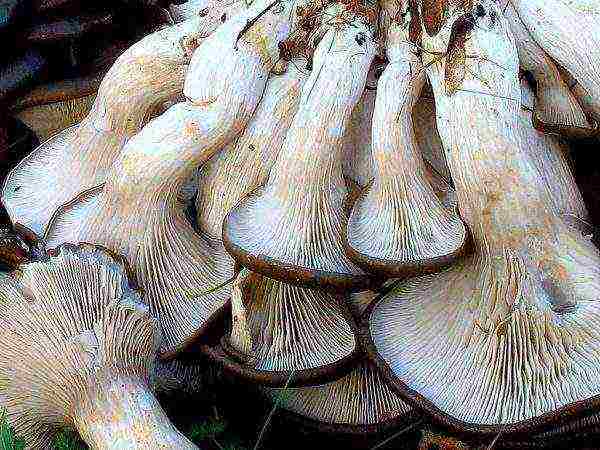
Growing and picking mushrooms
As soon as the growth of the mushrooms becomes noticeable, cuts are made in the bags crosswise. There are about 11 holes per bag. All blocks are placed at a distance of 0.3 m from the floor to protect against pests.
At the stage of mushroom formation, abundant moisture is needed with a spray bottle. In winter, it would be nice to add steam, or flood the floor with water. It is quite easy to recognize a ripe mushroom - it has a formed and elastic inner side of the cap.
Moreover, the edge should be bent to the bottom. When the edges are straightened, the mushroom loses spores (and weight), accordingly, it is important to have time to harvest before that. When collecting, it is very important to pull out the mushroom, and not cut it off, because the cut site is a breeding ground for mold and other infections.
All work at home is carried out without fail in a mask, glasses and gloves. This is necessary not only for oyster mushrooms, but also to protect their own health.
Diseases of the mycelium
As soon as a slight fluff appears on the mycelium, this is a signal that the temperature regime is not being met. When the growing conditions change, the mycelium is formed incorrectly. To avoid this, or to eliminate such consequences, you should adjust the required humidity and temperature.
Also, puffing can be accompanied by dark or greenish spots on the block, which means that dirt has been brought in, either when planting mycelium, or in the process of caring for it.
If traces of mold appear, discard the affected block without regret. It is better to sacrifice one than to lose the entire crop. Immediately after this, a thorough sanitization of the premises is carried out.
Another common oyster mushroom disease is the fungus Artrobotrys pleuroti. Its signs are the loss of elasticity by the mushrooms, the appearance of yellowness and wateriness. Such an affected block is destroyed and the entire room is disinfected.
Possible mistakes when growing oyster mushrooms in the basement
On the formed mushrooms, a gray bloom may form, which means a defeat by the spider web. The mushroom becomes soft and its leg rots. All this happens very quickly due to the spread of mold.
Such blocks with defeat must be removed from the total mass and destroyed, since it is no longer possible to save the landing. Perhaps the pathogens were in the water, it also needs to be changed. All premises are treated with soda salt solution, sanitization of all surfaces is carried out.
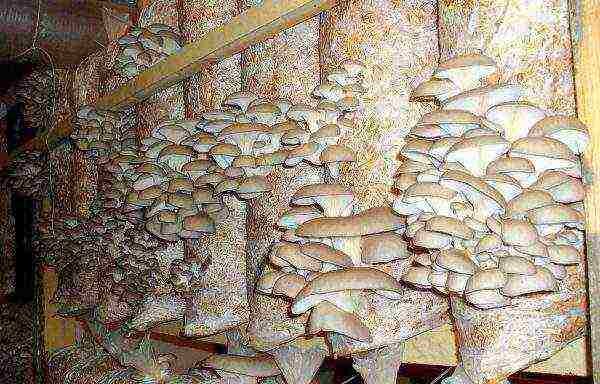
After the remaining healthy mushrooms have been harvested, replace the substrate with a new one and inoculate new mycelium.
If a musty odor appears under the bag material and condensation accumulates, then the substrate is too waterlogged. Waterlogging of a block of this kind occurs with the wrong method of irrigation - you need to use a spray bottle instead of a watering can.
Alternatively, the drainage holes are insufficient for adequate ventilation, their number should be increased. General ventilation of the room can also help - if it is lacking, the optimal microclimate of the basement will be disturbed, which will lead to a delay in the growth of the fungus and its drying out.
The selection of ventilation is individual and is chosen empirically. If an excess of carbon dioxide accumulates in the air, then the entire mushroom is deformed at all stages of development - its leg becomes too long, the cap is very small and a curved funnel, the whole mushroom is bent beyond recognition.
It can also be at low humidity or lack of lighting. Immediately after revealing such a fact, change the backlighting and ventilation modes of the basement. Growing oyster mushrooms in the basement does not require much effort, time or solid knowledge.
Compliance with all the rules for the reproduction of mushrooms and the technology of caring for them will make it possible to equip mushroom plantations in the basement and harvest crops all year round. If you wish, you can master the cultivation of other types of mushrooms, such as champignons or porcini mushrooms.
Growing Oyster mushrooms in the basement.avi
 Growing an oyster mushroom in a home basement is a trend that came from the 90s. Craftsmen mastered this business from scratch, planted entire plantations in such conditions and built a business on them. It is not difficult to grow oyster mushrooms - it is important to adhere to the step-by-step algorithm and instructions. This article contains the recommendations of experts on where to start the process and how best to carry it out. Photo and video tips are provided to help beginners.
Growing an oyster mushroom in a home basement is a trend that came from the 90s. Craftsmen mastered this business from scratch, planted entire plantations in such conditions and built a business on them. It is not difficult to grow oyster mushrooms - it is important to adhere to the step-by-step algorithm and instructions. This article contains the recommendations of experts on where to start the process and how best to carry it out. Photo and video tips are provided to help beginners.
Step 1: preparing the room
To organize home growing of oyster mushrooms, you need a properly equipped room, high-quality mycelium (mycelium), and a suitable substrate. In the basement, mushrooms are grown in two ways:
- Natural. Minimum equipment costs, but no more than one harvest per year.
- Intensive. Requires investment in order to create and maintain the microclimate necessary for oyster mushrooms in the basement. But it allows you to collect several crops per season, regardless of weather conditions.
Advice. Mushroom pickers often choose the second option. This technology will allow the family to feed and sell some of the mushrooms.
You should not count on a safe and healthy harvest if you cannot create and maintain such conditions in the basement:
- purity;
- air temperature in the range of + 10 ... + 20 ° C;
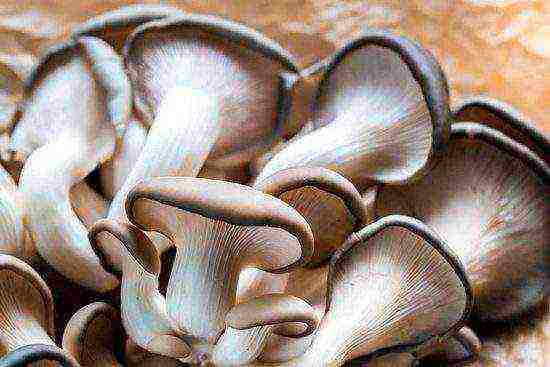
Oyster mushroom is easy to grow on your own
- humidity - 85-90%;
- constant air circulation, well-functioning ventilation;
- no pests and mold.
A deep cleaning in the first step will help detect problems in the basement. You may need a total rearrangement or re-equipment of the premises. To grow mushrooms in winter, take care of the tightness and insulation of the basement. Then, to maintain the microclimate in the cold, one heater will be enough for you, which will turn on for 2-3 hours.
Cover the ventilation openings with mosquito nets. Mold can be removed by hand using a special product or vinegar solution. As a preventive measure, a normal balance of temperature and humidity is sufficient. Remove pests using pest control: smoke bombs or chemicals. Further work in the basement can be started no earlier than in a week.
Step 2: preparing the substrate
When using the intensive growing method, the substrate acts as a comfortable, moist and breathable environment. It protects oyster mushrooms from mold damage. Experienced mushroom pickers use hardwood shavings. It is easier for beginners to work with buckwheat or sunflower husks, barley or wheat straw, dry corn stalks.
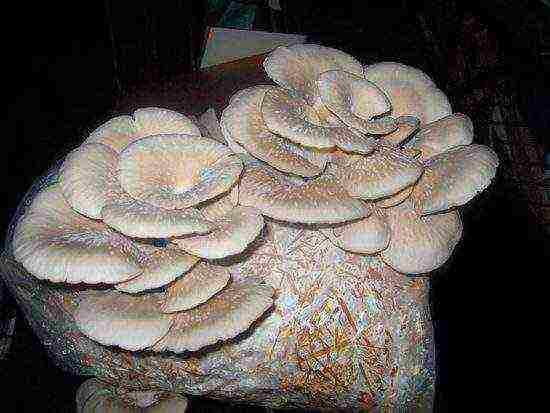
An important task is to properly prepare the substrate for growing.
Prepare the material before use:
- Make sure it is free of fungal microorganisms.
- Heat the raw materials: steam a dry or moistened substrate, boil in water. In the latter case, let the liquid drain for a few days. Such saturation with moisture is considered optimal when, when squeezed by hand, the substrate springs, but does not ooze with water.
- Cool and grind the material.
- Place the substrate in plastic bags with small holes. Transfer them to a separate, disinfected, warm room to place the mycelium.
- Use bleach for surface treatment. The same sterilization is needed in the basement.
Step 3: buy quality mycelium
In order not to make a mistake in choosing a basis for the reproduction of mushrooms, follow these recommendations:
- If you are not sure about the quality of the myceliums you are purchasing, take several small batches from different suppliers.
- When buying, study the data on the variety and strain, productivity, mold resistance, crop savings terms.
- The optimum temperature for mycelium is about +20 ° C. Make sure no overheated material is sold to you.
- The mycelium should not exude an ammoniacal odor and be covered with black or green spots. A healthy color is bright orange.

Oyster mushroom mycelium
After harvesting, the seed mycelium is stored in the refrigerator at a temperature of + 3 ... + 4 ° C. Under such conditions, normal mycelium will retain productivity up to 3 months, substrate mycelium - up to 9 months. Check with sellers for compliance with these conditions. After purchasing mycelium:
- place the bags separately in a well-ventilated room;
- leave for a couple of hours at room temperature;
- before laying, grind the mushroom base without opening the bag.
Attention! It is necessary to open the package and carry out all subsequent operations only with gloves, in a sterile environment. After opening, treat the mycelium with a disinfectant solution.
Step 4: laying the mycelium
You will need a sterile table. The bags also need to be treated with a disinfectant solution, and then with water. Turn off ventilation, close windows and doors during work. Mix the substrate and mycelium directly on the work surface. Correct proportions for mycelium:
- domestic raw materials - 3-5% of the total volume of the substrate;
- foreign product - 1.6-2.5%.
Put the mixture back into bags and tamp. The optimal weight of one bale should be 5-15 kg. Flatten the bags lightly and using a sharp knife, cut openings on both wide sides. The length of one is 0.5 cm. This technique will lead to the fact that the mushrooms will break through in bunches.
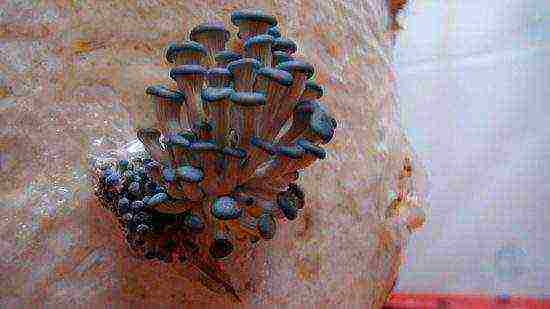
Place mycelium under sterile conditions.
Place the bags on props or shelves in the same room.The bags should be at least 5 cm away from walls and each other and should be well blown from all sides. The most favorable air temperature is around +25 ° C. In the block with the substrate, it may be slightly higher. Sowing maintenance is simple:
- do not ventilate the room;
- Wipe floors and surfaces with chlorine and water every day.
Attention! Do not overheat mycelium at + 30 ° C or higher.
Step 5: growing oyster mushrooms in the basement
In a warm room, the bags should lie for 18-25 days. After that, they should be transferred to the basement. There the blocks are placed vertically. They can be placed on top of each other, however, a gap of at least 0.5 m is required between the columns. The first mushrooms can be collected after 1.5 months. after laying the mycelium.

Growing oyster mushrooms in the basement
In the basement, you need to maintain optimal conditions for growing oyster mushrooms. The desired lighting intensity is 5 W / sq. m. In order for the body of the fungus to mature dense, and not watery, use a humidifier or sprayer for irrigation. Water with a temperature of + 10 ... + 25 ° C should flow from top to bottom no more than twice a day. Ventilate the area after watering.
Attention! Oyster mushrooms form a lot of controversy. To prevent them from causing allergies, the basement must be isolated from the living rooms.
Subsequent waves of fruiting in oyster mushrooms occur with an interval of 2-3 weeks. Remnants of the mushroom legs should be removed between these periods. Go through the bags. If you notice mold, remove it from the room. Such a substrate will fit on the site as an organic fertilizer. It is easy to grow oyster mushrooms in the basement, especially if you are well prepared for the process.
Growing oyster mushrooms at home: video
Every year more and more people want to grow various crops at home. Thus, vegetables, fruits, herbs receive quality care and are considered completely organic. The use of chemicals and fertilizers is kept to a minimum.
Mushroom growing is also popular now and this activity does not require large expenses, and the room can be even the smallest to get a large number of mushrooms.
The leader among home cultivation can be considered the Royal oyster mushroom. But you need to find out how to grow oyster mushrooms at home. After all, there is a special technology that should be followed.
How to choose a place to grow
It is very important to decide on the room where the oyster mushrooms will be grown. For effective cultivation of mushrooms, including oyster mushrooms or champignons, high-quality air circulation is needed.
Another key indicator is humidity, which should be at 50% or more. Often, experts grow oyster mushrooms in a basement, shed, or in an ordinary greenhouse. Here, mushroom blocks will not interfere with anyone, and the harvest will grow calmly.
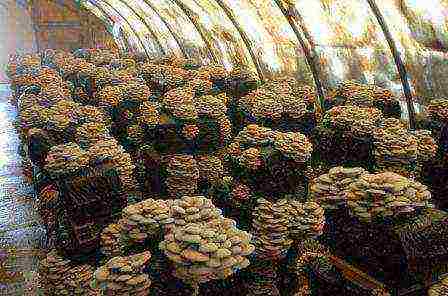
However, for the cultivation of such unpretentious mushrooms as oyster mushroom, any room that has the following conditions can be suitable:
- high air humidity - about 70%;
- be sure to observe complete darkness for the first 20 days;
- the use of artificial light - as soon as the oyster mushrooms in bags form the first rudiments, you need to use additional lighting, about 8 hours a day;
- compliance with the temperature regime. Indicators should be at the level of +20 - 30 degrees;
- high-quality ventilation. Airing is very important for the quality of the mushroom harvest.
The most common mistake when growing oyster mushrooms on your own is poor choice of where to grow. If the technology for growing oyster mushrooms is violated, then the harvest may not be at all.
The basis for growing oyster mushrooms
Before starting to grow oyster mushrooms at home, you need to thoroughly study all the requirements for the substrate, because it is that nutrient medium for mushrooms, and the yield will depend on it. It is important not to make mistakes so that the cultivation of oyster mushrooms is crowned with success.
It is worth saying that there is another method of growing oyster mushroom - when a special base is not needed, and the mushrooms grow on stumps or trees. But about this you need to find out more detailed information and use the secrets of specialists.
Mycelium selection
Growing oyster mushrooms at home for a beginner is already considered quite difficult, you do not need to make common mistakes and not buy mycelium from your hands. It is better to go to specialized stores where you can choose the best option. Beginners can choose mycelium that has been used industrially for about 1 year.
And there is a certain secret in this, because the industrial technology of growing mushrooms does not imply the use of mycelium for more than 1 year. But, during this period, the mixture does not fully develop its resource, and continues to bear fruit well. Such mycelium usually gives a large and high-quality harvest, and the price for it is much lower.
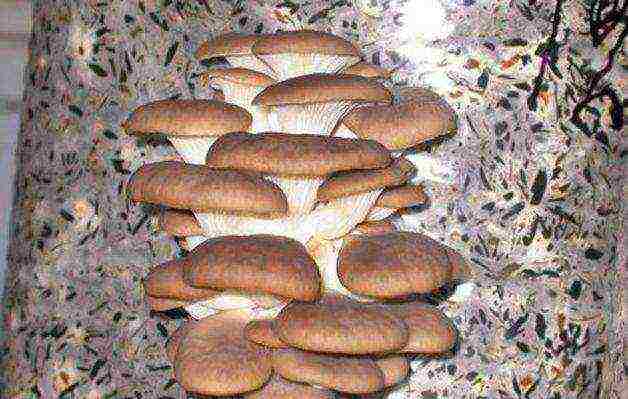
First you need to select the correct amount of mycelium for growing. If you buy a mycelium for a summer residence where the mushrooms will grow well, keep in mind that with 1 kg of mycelium, about 3 kg of mushrooms are obtained. But how many mushrooms grow remains to be seen.
Purchasing quality mycelium
When buying mycelium in a store, you need to use the following selection rules that will help not only a beginner, but also an experienced mushroom grower:
- if you are not sure of the quality of the purchased mycelium, you need to take several small batches from different manufacturers or stores;
- at the time of purchase, you need to study the data on the variety and strain, productivity, resistance to various diseases and pests. And also be sure to familiarize yourself with the timing of saving the crop;
- familiarize yourself with the conditions under which the mycelium is preserved. The optimum temperature should be +20 ° C. Be careful not to be sold overheated material;
- mycelium should not have a pronounced ammonia odor, should not be covered with black or green spots. This will mean that it is of poor quality. A healthy mycelium color that is ideal for growing is a bright orange.
The main stages of breeding oyster mushrooms
If you disassemble the process step by step, it includes the following stages:
- Preparation and processing of the substrate. A substrate can be called a nutrient medium for germination of fungi, in other words, it is soil. Sunflower husks, straw, buckwheat husks can be used as raw materials. The main condition for cooking is the use of pure material. The substrate must be pre-crushed. This is necessary in order to avoid the ingress of microorganisms and foreign particles into it, which can affect the harvest. For this, the substrate is treated with steam. The process itself is that the substrate (about 10 kg) is placed in a special container and heated. It takes about 2 hours to cook the substrate. Then you need to drain the water and cool the substrate to a temperature of 25 ° C.
The most popular processing of the substrate today can be considered xerothermal technology. The essence of this process is that the substrate is heated with steam to 100 ° C and kept for a certain amount of time (1.5 hours if it is straw). After the end of the process, the substrate is moistened with water. - Formation of mushroom blocks. Mushroom blocks look like large polyethylene bags 350x800 mm in size, which are filled with a substrate. To form them, it is necessary to place the substrate and mycelium in layers in pre-steamed bags, alternating them constantly with each other. The top layer should be a substrate. After the bags are filled, they need to be tied. Next, you need to make small holes (1-2 mm) in the bag, leaving a distance of 10 cm between them.
- Correct seedling care. After the mushroom blocks have been formed, the incubation period begins (the period when oyster mushrooms ripen).At this stage, it is important to create the best conditions for the mushrooms. It is important to monitor the temperature regime in the bags (the optimum temperature will be + 20 ° C). In addition, the room must be regularly ventilated. The incubation period lasts 2-3 weeks, after which the mycelium, which has grown to be transferred to another room, in order for the growing process to take place.
- Fruiting. Mushrooms begin to bear fruit on the 7-10th day, after the mycelium has been transferred to a new room. At this time, the first rudiments of fungi begin to appear. This stage also requires an increase in air humidity up to 100%. For this, the floor and walls of the room must be sprayed with water. Airing during this period should be carried out even more often. Also, mushrooms need lighting for up to 10 hours a day. Such lighting can be purchased at a specialized store or you can use ordinary fluorescent lamps.
- Harvesting. It is generally accepted that the correct harvest is the twisting of oyster mushrooms from the substrate. This is due to the fact that during pruning with a knife, various microorganisms can enter the mycelium, which will affect further growth.
It should also be remembered that you need to harvest in whole groups, so the oyster mushroom will not lose its qualities and will last longer.
In one room, you can carry out 4-5 rotations (continuous cultivation) per year. Important! After the harvest has been collected, the room must be thoroughly washed with water, disinfected and thoroughly ventilated.
Oyster mushroom diseases and pests. How to prevent and control
There are times when mushrooms get sick during the fruiting period. There are many reasons. If disinfection was carried out in the room, diseases should not affect the crop. As a rule, bacteria enter along with wet and rotten straw. This causes various fungal diseases of the substrate.
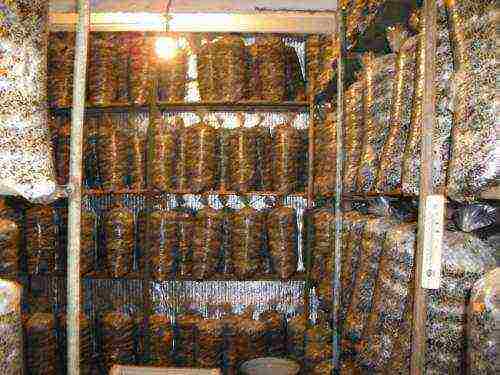
Important! To prevent disease, the substrate must be thermally treated before the mycelium is planted. To do this, place it in a large container and pour boiling water over it, then cook for 2 hours, then squeeze and dry.
You can often find such a disease as dark rot. If you see this, you need to remove all diseased plants along with the substrate. Very often oyster mushrooms are attacked by mushroom flies, less often by ticks. Parasites are also born in the mycelium due to excessive humidity and lack of ventilation. The disease appears as light spots.
Such mushrooms need to be removed and the room disinfected. You can do this with the help of smoke, which can be bought in the store, it is left for a day in a closed room, after which you need to do high-quality ventilation.
If at least one of the myceliums is infected, you need to throw away the entire bag, and this reduces the amount of harvest.
Based on the foregoing, one can understand that it is very simple to grow oyster mushrooms at home, but quite laborious. Equipment, quality materials, lighting and a special room are needed. But proper care makes it possible to collect up to 9 kg of mushrooms.
For more information on growing, see here:
